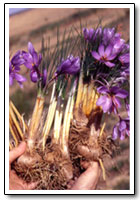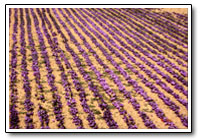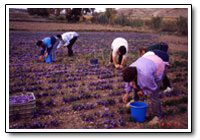Home | FOOD ARTICLES | Food Trivia | Today_in_Food_History | Food_History_Timeline | Recipes | Cooking_Tips | Food_Videos | Food_Quotes | Who’s_Who | Culinary_Schools_&_Tours | Food_Trivia_Quizzes | Food_Poems | Free_Magazines | Food_Festivals_and_Events
Food Articles, News & Features Section
FREE Magazines
and other Publications
Free Professional and Technical Research, White Papers, Case Studies, Magazines, and eBooks
SAFFRON FIELD REPORT
See also:
Article, Saffron Quality;
Saffron Trivia
Spice Buyer’s Journal: Destination Spain
McCormick’s chief spice buyer, Al Goetze, travels to exotic ports-of-call, trekking across varied terrain in search of the finest herbs and spices. In this journal entry, Al gives us a behind-the-scenes look at one of the most prized spices – saffron – as he recounts his recent trip to Spain, the world’s premier source for this culinary jewel.
Saffron’s rich color and distinct flavor and aroma put it in a class by itself. Even more intriguing is the fact that the entire harvesting, drying and packaging process is done by hand. Saffron has been a part of Mediterranean history for thousands of years, and has been used as a flavoring, a natural dye, and even as perfume in ancient Egyptian and Roman times. Let me share with you the saffron story, and by the end of this journal, I’m sure you’ll agree that saffron is truly a treasure. The saffron crocus, Crocus sativus, is a small, purple flower that blooms every fall in Spain, Greece, India, and Iran. Saffron, the spice as we know it, is the bright red-orange stigma from this crocus. Each flower contains three stigmas, of approximately one inch in length. Total annual world production of saffron is less than 200 metric tons – just over 440,000 pounds.
The saffron crocus, Crocus sativus, is a small, purple flower that blooms every fall in Spain, Greece, India, and Iran. Saffron, the spice as we know it, is the bright red-orange stigma from this crocus. Each flower contains three stigmas, of approximately one inch in length. Total annual world production of saffron is less than 200 metric tons – just over 440,000 pounds.
In South Central Spain, just below Madrid, is a province called Castilla La Mancha. It is a beautiful agricultural countryside made up of mountains and plateaus. One of the key areas we visited was near the town of Consuegra. Here, we saw vast numbers of old windmills, which were previously used to mill grains grown in the area. It was against this backdrop that we got a glimpse of our first field. Rows of the distinctive purple flowers lined the landscape. My local expert, Pepe, explained that each October, the crocus bulbs come to life. In fifteen days, the flowers reach maturity, with their colorful stigmas fully developed into the characteristic red-orange color.
My local expert, Pepe, explained that each October, the crocus bulbs come to life. In fifteen days, the flowers reach maturity, with their colorful stigmas fully developed into the characteristic red-orange color.
Saffron stigmas must be harvested in such a way that they do not excessively rub against the pollen rods, which can contaminate their exquisite color. For this reason, farmers like to harvest the flowers early in the morning on the first day they are in bloom, while the flower petals are still closed. Pepe told me that each crocus bulb produces about five new flowers over a short period of time. This means that the farmers must rally a large workforce in the villages to carry out the harvest.
After harvest, flowers are taken to warehouses where villagers sit around tables and carefully separate the stigmas from each bud. Once the stigmas have been removed, they are lightly dried over charcoal embers.
Villagers must keep close watch over the drying process to ensure there is no scorching, which results in loss of flavor and aroma. It is interesting to note that the stigmas lose about 75 percent of their weight during the drying process. In fact, Pepe informed me that because of this, it takes more than 225,000 stigmas to make just one pound of dried saffron! Only whole stigmas of saffron can be guaranteed to be true saffron.

Dried saffron is packed in metal tins, where it can be kept for several years. Saffron has a perfumey, slightly bitter, honey-like flavor. A “spirited” tidbit I picked up on this trip is that aged saffron is used to make vermouth, as its bitter notes intensify over time.
The tins are then shipped to the United States, where workers weigh the threads on digital scales before packaging them – by hand – in a cellophane envelope, which is then put into a white paper envelope. Once inside these protective coverings, the saffron is sealed into a glass bottle for freshness.
This detailed process – from harvest through bottling – accounts for saffron’s premium price, but fortunately, a little of its extraordinary flavor goes a long way!
Upon our return, we stopped at a roadside country restaurant and had some of the best paella I have ever tasted. The local seafood and chorizo sausage, flavored with saffron, was absolutely wonderful and the perfect way to end our visit.
Saffron is widely used in Mediterranean, North African and South American cooking. It can be used in sweet and savory dishes.
About McCormick
McCormick was founded in 1889 in Baltimore, Md. Today it is the largest spice company in the world. McCormick sources only the finest ingredients from around the globe to bring the highest quality flavors to consumers. For more information, visit McCormick online at www.mccormick.com, or call 1-800-MEAL-TIP (1-800-632-5847).
RELATED ARTICLES
Please feel free to link to any pages of FoodReference.com from your website.
For permission to use any of this content please E-mail: james@foodreference.com
All contents are copyright © 1990 - 2026 James T. Ehler and www.FoodReference.com unless otherwise noted. All rights reserved.
You may copy and use portions of this website for non-commercial, personal use only.
Any other use of these materials without prior written authorization is not very nice and violates the copyright.
Please take the time to request permission.

